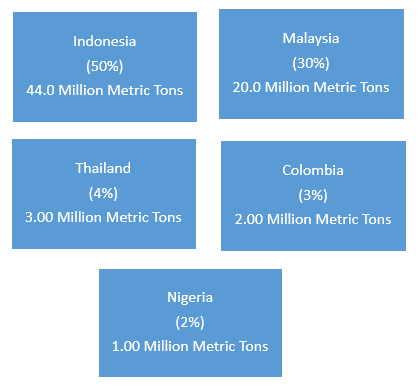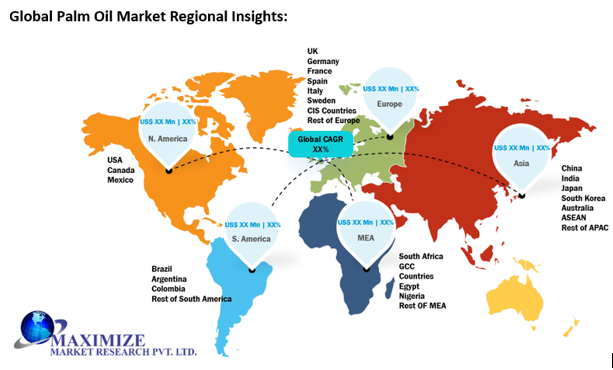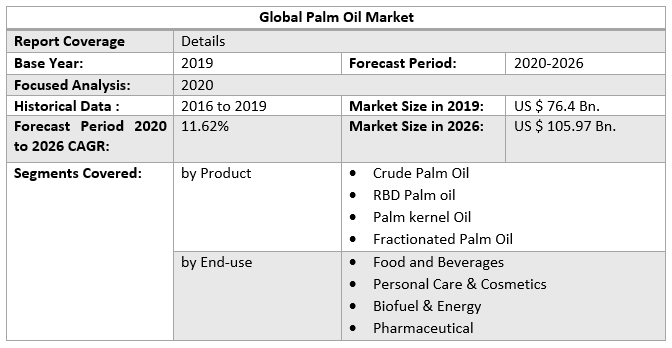Global Palm Oil Market size was valued at US$ 76.4 Bn in 2019 and the total revenue is expected to grow at 11.62% through 2020 to 2026, reaching nearly US$ 105.97 Billion. The Global Palm Oil Market report is a comprehensive analysis of the industry, market, and key players. The report has covered the market by demand and supply-side by segments. The Global Palm Oil Market report also provides trends by market segments, technology, and investment with a competitive landscape.  To know about the Research Methodology :- Request Free Sample Report
To know about the Research Methodology :- Request Free Sample Report 
 The objective of the report is to present a comprehensive analysis of the Global Palm Oil Market to the stakeholders in the industry. The past and current status of the industry with the forecasted market size and trends are presented in the report with the analysis of complicated data in simple language. The report covers all the aspects of the industry with a dedicated study of key players that include market leaders, followers, and new entrants. PORTER, PESTEL analysis with the potential impact of micro-economic factors of the market have been presented in the report. External as well as internal factors that are supposed to affect the business positively or negatively have been analysed, which will give a clear futuristic view of the industry to the decision-makers. The report also helps in understanding the Global Palm Oil Market dynamics, structure by analyzing the market segments and project the Global Palm Oil Market size. Clear representation of competitive analysis of key players by product, price, financial position, product portfolio, growth strategies, and regional presence in the Global Palm Oil Market make the report investor’s guide.
The objective of the report is to present a comprehensive analysis of the Global Palm Oil Market to the stakeholders in the industry. The past and current status of the industry with the forecasted market size and trends are presented in the report with the analysis of complicated data in simple language. The report covers all the aspects of the industry with a dedicated study of key players that include market leaders, followers, and new entrants. PORTER, PESTEL analysis with the potential impact of micro-economic factors of the market have been presented in the report. External as well as internal factors that are supposed to affect the business positively or negatively have been analysed, which will give a clear futuristic view of the industry to the decision-makers. The report also helps in understanding the Global Palm Oil Market dynamics, structure by analyzing the market segments and project the Global Palm Oil Market size. Clear representation of competitive analysis of key players by product, price, financial position, product portfolio, growth strategies, and regional presence in the Global Palm Oil Market make the report investor’s guide.

 To know about the Research Methodology :- Request Free Sample Report
To know about the Research Methodology :- Request Free Sample Report Global Palm Oil Market Overview:
Global Palm Oil market Size was valued at US$ 76.4 Bn in 2019, the total revenue is expected to grow at 11.62% through 2020 to 2026, reaching nearly US$ 105.97 Bn by 2026. Global palm oil refers to an edible vegetable oil that is gained from mesocrap of the fruit of palm oil. Palm oil is used as a key ingredient of daily use products such as shampoo, detergent, ice cream, bio diesel, chocolate etc. Generally it could be used in food manufacturing, in personal care & cosmetic products, in biofuel and energy, and in pharmaceuticals. It is used as cooking oil and it is available in many grocery stores. It is important vegetable oil and food and non-food both industries use it as raw material. There are some features of palm oil – it is cholesterol free, it has a unique fatty acid and TAG profile. It has a rich source of emulsifiers, fatty acids, and vitamin E. Palm oil accounted for about 33% of global oils produced from oil crops in 2014.Impact of Covid-19 on Palm Oil Market
Production and consumption in the producing and consuming countries have been impacted much due to lockdown, restrictions on transportation which resulted in low supply chain and restrictions along the nation’s borders. There are 65% foreign labour in Malaysian palm oil sector and only 30% plantation workforce are Malaysian. So, this has resulted labour’s shortage at the country’s palm oil plantations. This has resulted in lower palm oil production, which went down 3.8% in 2020. India is biggest importer of palm oil market, and palm oil imports in august 2020 dropped 14.0%.Global Palm Oil Market Dynamics:
Palm, the world’s largest yielding oil crop, is now perceived as being a more natural product whose naturalness could be exploited regarding physical wellbeing leading to helping consumers achieve a healthy life and higher self-stem. Palm oil provides many nutritional benefits since it is cholesterol-free, easy to digest and rich in carotenoids, as well as Vitamin A. Palm oil is cheaper than other vegetable oil available in the market such as sunflower, exotic oils, coconut oil. The use of palm oil has great concerns regarding the current condition of forests and plant diversities, due to deforestation in the tropics where palm oil is growing, and there are allegations of human right violations. Palm oil leads to an increase in much environmental pollution and also produces fuel for air pollution, soil erosion and climate change. Some countries are trying to use sustainable and organic palm oil i.e. Indonesia and Malaysia. Displacement and disruption of human and animal populations is also cause of concern. Due to increasing cultivation of palm oil in Malaysia, over 1.1 million hectare of tropical rainforest was lost. Crude oil accounts for 64% of the shares in the global Sustainable Palm Oil market, many Indonesian palm oil plantations are working to get certified as environment friendly. These certifications are approved by (RSPO) Roundtable on sustainable palm oil. Emerging economies such as China & India along with Europe and several consumer goods firms have made public commitments to sourcing sustainable palm oil. For example, Unilever, the world’s largest palm oil buyer, wants 100% of its pam oil to be physically certified. The increasing market penetration in the top cultivating regions like Indonesia, Malaysia, and Thailand is the primary factor for market expansion. Increasing demand for sustainable palm oil in the various end-use segments will boost the sales of sustainable palm oil during the forecast period.Global Palm Oil Market Trends:
Readily replacing petroleum-based products as an effective alternative in the transportation and energy industries. Palm oil provides numerous health benefits like reducing the risk of cancer, heart diseases, and provides nutritional benefits among consumers. These all are primary factors. But in a recent survey it is found almost two-third 60% of the palm oil imported into European Union was burned as energy, in which 50% was used for making cars and trucks and 10% for creating electricity.Global Palm Oil Market Segment Analysis:
The Global Palm Oil market is segmented in main three types and they are by product, end- use. On the basis of product segment the global palm oil market is sub segmented in four different types and they are Crude palm oil, RBD palm oil, Palm kernel oil, Fractionated palm oil. Crude palm oil contributed the highest market share in the segments of palm oil market in 2019, accounting for 55% of the total revenue and is estimated to grow at a CAGR of 5.0% during the forecast period. Generally the color of palm is red because of its high beta-carotene content and it is used in commercial kitchens because of low cost. Crude palm oil is different from Kernel oil or coconut oil. Crude palm oil is used for cooking purposes and South-East Asia, West Africa are the largest producers of crude palm oil. Indonesia, Malaysia, Nigeria and Columbia are major exporters of crude palm oil. RBD (refined, bleached, deodorized) is edible vegetable, is projected to be the fastest growing segment and register the highest CAGR during forecast period (2020-2025). By end- use segment the global palm oil market is sub segmented into four different types they are Food & Beverages, Personal care & Cosmetics, Biofuel and Energy and Pharmaceuticals. Biofuel and Energy segment is dominating in terms of share. The Biofuel & Energy segment had accounted for revenue share of 20% in 2019 and expected to reach the highest growth throughout the forecast period. Biodiesel has gained tremendous popularity among consumers because increasing demand of renewable energy and eco-friendly resources has contributed as a major factor for the market growth of this segment. The Malaysian government is planning to mix 5 percent palm biodiesel with 95 percent petroleum diesel. More than 60% of palm oil was imported in the EU, Was related to energy. The Biofuel palm oil market is also used to make biodiesel for cars and trucks. The Southeast Asian palm oil for biodiesel will enhance greenhouse gas emission by 3 to 6 times. Palm oil is also used as an alternative for mineral oil in power stations for energy production. Palm oil is a good substitute for petroleum- based products and also palm oil is an alternative to replace fossil fuel as the demand for energy source and Southeast Asian palm oil is also an alternative feedstock in the production of biodiesel. Using palm oil in biofuel enhances greenhouse emissions. Using palm oil in biofuel is good because it reduces CO2 emissions after converting palm oil into biodiesel. Key Palm Oil Producing Countries Palm oil is produced nearly 80% just in two countries- Indonesia and Malaysia, According to data from the United States Department of Agriculture. Indonesia produced 44.0 million tons of palm oil which is 50% of the world’s production and 20 million tons of palm oil was produced by Malaysia which is 30% of global production.
Global Palm Oil Market Regional Insights:
Asia-Pacific dominates the regional segment of Palm Oil Market with a share of more than 35% in 2019. Asia-Pacific held the first position in the geographical segment due to growing disposable income, contributing major palm oil production, and rapidly growing consumer use. Malaysia is one of the largest palm oil exporters to the United Arab Emirates. Malaysia and Indonesia are the top producers of palm oil market in the world, accounting for 75% of global production. The second position is held by North America in the regional market, due to changing taste, lifestyle of consumers towards healthy eating habits and enhancing knowledge about palm oil market. The top palm oil consuming countries are – Indonesia, India, EU, China, Malaysia, Pakistan, Thailand, Bangladesh, and the United States. The top importing countries are India- 23%, EU- 18%, China- 12%, and Pakistan- 8%, others- 39% The objective of the report is to present a comprehensive analysis of the Global Palm Oil Market to the stakeholders in the industry. The past and current status of the industry with the forecasted market size and trends are presented in the report with the analysis of complicated data in simple language. The report covers all the aspects of the industry with a dedicated study of key players that include market leaders, followers, and new entrants. PORTER, PESTEL analysis with the potential impact of micro-economic factors of the market have been presented in the report. External as well as internal factors that are supposed to affect the business positively or negatively have been analysed, which will give a clear futuristic view of the industry to the decision-makers. The report also helps in understanding the Global Palm Oil Market dynamics, structure by analyzing the market segments and project the Global Palm Oil Market size. Clear representation of competitive analysis of key players by product, price, financial position, product portfolio, growth strategies, and regional presence in the Global Palm Oil Market make the report investor’s guide.
The objective of the report is to present a comprehensive analysis of the Global Palm Oil Market to the stakeholders in the industry. The past and current status of the industry with the forecasted market size and trends are presented in the report with the analysis of complicated data in simple language. The report covers all the aspects of the industry with a dedicated study of key players that include market leaders, followers, and new entrants. PORTER, PESTEL analysis with the potential impact of micro-economic factors of the market have been presented in the report. External as well as internal factors that are supposed to affect the business positively or negatively have been analysed, which will give a clear futuristic view of the industry to the decision-makers. The report also helps in understanding the Global Palm Oil Market dynamics, structure by analyzing the market segments and project the Global Palm Oil Market size. Clear representation of competitive analysis of key players by product, price, financial position, product portfolio, growth strategies, and regional presence in the Global Palm Oil Market make the report investor’s guide.
Global Palm Oil Market Scope: Inquire before buying
